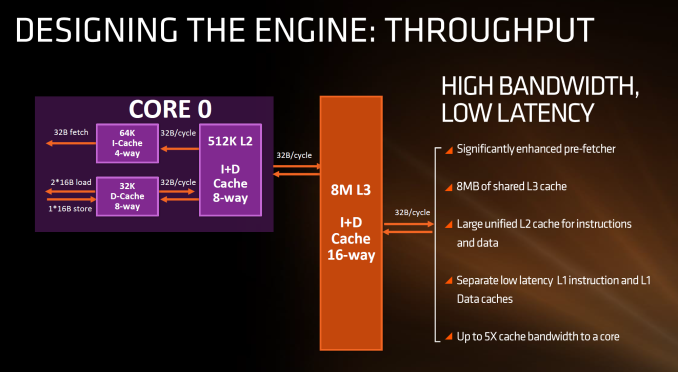AMD Zen Microarchitecture: Dual Schedulers, Micro-Op Cache and Memory Hierarchy Revealed
by Ian Cutress on August 18, 2016 9:00 AM ESTDeciphering the New Cache Hierarchy
The cache hierarchy is a significant deviation from recent previous AMD designs, and most likely to its advantage. The L1 data cache is both double in size and increased in associativity compared to Bulldozer, as well as being write-back rather than write-through. It also uses an asymmetric load/store implementation, identifying that loads happen more often than stores in the critical paths of most work flows. The instruction cache is no longer shared between two cores as well as doubling in associativity, which should decrease the proportion of cache misses. AMD states that both the L1-D and L1-I are low latency, with details to come.
The L2 cache sits at half a megabyte per core with 8-way associativity, which is double that of Intel’s Skylake which has 256 KB/core and is only 4-way. On the other hand, Intel’s L3/LLC on their high-end Skylake SKUs is at 2 MB/core or 8 MB/CPU, whereas Zen will feature 1 MB/core and both are at 16-way associativity.
Edit 7:18am: Actually, the slide above is being slightly evasive in its description. It doesn't say how many cores the L3 cache is stretched over, or if there is a common LLC between all cores in the chip. However, we have recieved information from a source (which can't be confirmed via public AMD documents) that states that Zen will feature two sets of 8MB L3 cache between two groups of four cores each, giving 16 MB of L3 total. This would means 2 MB/core, but it also implies that there is no last-level unified cache in silicon across all cores, which Intel has. The reasons behind something like this is typically to do with modularity, and being able to scale a core design from low core counts to high core counts. But it would still leave a Zen core with the same L3 cache per core as Intel.
| Cache Levels | ||||
| Bulldozer FX-8150 |
Zen | Broadwell-E i7-6950X |
Skylake i7-6700K |
|
| L1 Instruction | 64 KB 2-way per module |
64 KB 4-way | 32 KB 8-way | 32 KB 8-way |
| L1 Data | 16 KB 4-way Write Through |
32 KB 8-way Write Back |
32 KB 8-way Write-Back |
32 KB 8-way Write-Back |
| L2 | 2 MB 16-way per module |
512 KB 8-way | 256 KB 8-way | 256 KB 4-way |
| L3 | 1 MB/core 64-way |
1 or 2 MB/core ? 16-way |
2.5 MB/core 16/20-way |
2 MB/core 16-way |
What this means, between the L2 and the L3, is that AMD is putting more lower level cache nearer the core than Intel, and as it is low level it becomes separate to each core which can potentially improve single thread performance. The downside of bigger and lower (but separate) caches is how each of the cores will perform snoop in each other’s large caches to ensure clean data is being passed around and that old data in L3 is not out-of-date. AMD’s big headline number overall is that Zen will offer up to 5x cache bandwidth to a core over previous designs.











216 Comments
View All Comments
pogostick - Friday, August 19, 2016 - link
What's all this bickering about AMD and Intel. Open your eyes people. There is only one master x86 cpu company and it is VIA. Soaring on their successful acquisition of the Cyrix remains, they've forged ahead to make blisteringly fast products like their 64 bit QuadCore E-Series. It beats everything but my wife. Geez. You guys are CLUELESS.AndrewJacksonZA - Friday, August 19, 2016 - link
Hahahahaha!belph - Friday, August 19, 2016 - link
Competition is back (?)patel21 - Friday, August 19, 2016 - link
Yes sir, it sure is.Rickkins1 - Friday, August 19, 2016 - link
Without the competition that AMD provides, Intel cpu's would be priced out of range for most people.Michael Bay - Friday, August 19, 2016 - link
And then you remember that AMD didn`t provide any competition worth of note for the past eight years.just4U - Friday, August 19, 2016 - link
Ofcourse they did.. just not on the highest end of the scale. The PII was a great chip. The FX line is decent but hasn't really seen much love.. and their APU is an excellent product.Meteor2 - Friday, August 19, 2016 - link
Quite. Intel have only been competing against themselves these last years.Makaveli - Friday, August 19, 2016 - link
If that is true then why haven't Intel prices increase substantially in the last 10 year where AMD has not been competitive?Maybe because Intel competes with their own previous gen chips. AMD being the reason for Intel's keeping prices in check only works when they have a product that competes and forces them to.
BMNify - Friday, August 19, 2016 - link
so, what did AMD do to improve generic x264/x265 data throughput on 10bit 1080P and especially UHD1 rec.2020 software encoding throughput ?what did AMD do to improve ffmpeg and related downstream hardware UHD1 encoding/streaming etc.